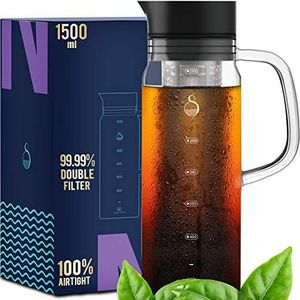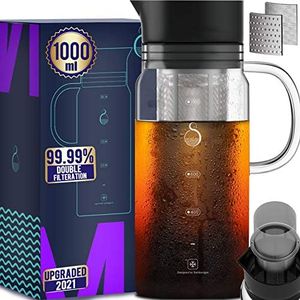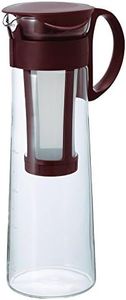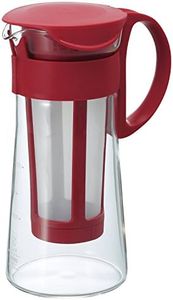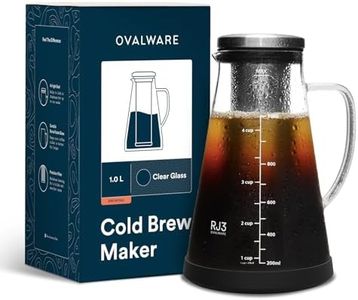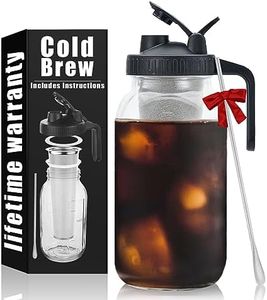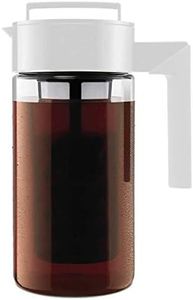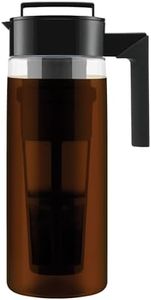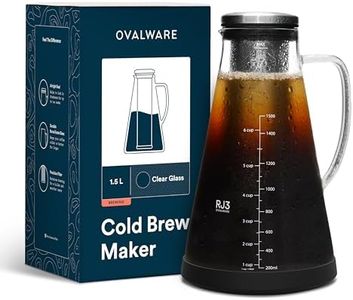We Use CookiesWe use cookies to enhance the security, performance,
functionality and for analytical and promotional activities. By continuing to browse this site you
are agreeing to our privacy policy
10 Best Cold Brew Coffee Makers
From leading brands and best sellers available on the web.Buying Guide for the Best Cold Brew Coffee Makers
Choosing the right cold brew coffee maker starts with knowing how much coffee you want to make, how hands-on you want to be with the process, and what kind of taste experience you’re after. Cold brew is loved for its smooth, less acidic flavor, and making it at home can be easy and rewarding. Think about your kitchen space, how often you’ll use the maker, how much time you have for brewing and cleaning, and whether you’ll drink cold brew straight or use it as a base for other drinks. Understanding the key specifications will help you find a cold brew coffee maker that fits your lifestyle and brewing preferences.CapacityCapacity refers to how much cold brew coffee the maker can produce in one batch. It’s usually measured in ounces or liters. A small-capacity brewer (around 16–32 ounces) is best for individual use or occasional drinkers, while medium-sized makers (around 32–64 ounces) suit those who want a batch that lasts several days. Large brewers (over 64 ounces) work well for families or entertaining guests. Pick the right capacity by thinking about how much cold brew you typically drink in a few days and how often you want to brew fresh batches.
Filtration SystemThe filtration system is what separates the coffee grounds from your finished cold brew, affecting both taste and ease of cleaning. Systems range from fine mesh stainless steel filters, to paper filters, or built-in plastic mesh. Fine metal or mesh filters let more oils and flavors pass through for a richer cup, while paper filters catch more sediment but may require repurchasing. If you prefer a cleaner cup and easier cleanup, look for fine mesh or double filtration. Choose a filter type that matches how much texture you want in your cold brew and how much maintenance you’re comfortable with.
Brew TimeBrew time is the number of hours the coffee needs to steep before it's ready. Most cold brew coffee takes between 8 and 24 hours. Quick-brew devices may be finished in less than 8 hours, but the flavor may be milder. Longer brew times generally produce a stronger, more concentrated flavor. If you want maximum convenience and flexibility, look for a maker that works within your typical daily routine, whether you’re an overnight brewer or need something faster for last-minute batches.
Ease of CleaningEase of cleaning describes how simple it is to dismantle and wash your cold brew coffee maker after use. Some designs have multiple small parts and need to be washed by hand, while others are dishwasher safe or have fewer components. If you like low-maintenance appliances, look for makers with wide openings and minimal pieces. If you don’t mind washing by hand and want more brewing control, cleaning might not be as big a concern.
Build MaterialBuild material refers to what the coffee maker is made of, such as glass, plastic, or stainless steel. Glass tends to deliver a pure taste and looks stylish, but it’s breakable. Plastic is lightweight and less likely to break, but the taste may be affected if it’s not high quality. Stainless steel is durable, often insulated to keep drinks cold, but it may be heavier. If you care most about durability and portability, consider stainless steel or sturdy plastic. For the best taste clarity and visual appeal, glass is often preferred.
Serving and StorageServing and storage refers to how you pour and keep your cold brew once it's ready. Some makers have built-in spouts or taps for easy pouring, while others use removable carafes or pitchers you can store in the fridge. Makers designed for fridge door use are good for frequent sipping. If you want to make coffee ahead for the week, look for easy-to-store and pour options. Your daily routine—single servings versus batch prep—can help you decide which serving and storage features to prioritize.
